In a quiet, modern-day bedroom filled with the morning light, Kanata Kamado, a responsible and determined 16-year-old, stands by the bunk bed with a frustrated look on his face. His sharp gaze is fixed on his younger brother, Sumihiko Kamado, who is in deep sleep under a cheerful duck-patterned blanket, unaware of the ticking clock.
“Wake up already. You’re going to be late for school,” Kanata says, with his voice sharp but bearing tiredness of repetition. He’s done this countless times, and today seems no different. Sumihiko, the carefree 15-year-old, doesn’t even move a little bit. Instead, he lets out a sleepy groan, muttering, “I’ve woken up—” with his eyes still closed. Kanata narrows his eyes, crossing his arms in disbelief. “I’ve already said the same thing 28 times already,” he declares, his patience clearly wearing thin. But Sumihiko remains unbothered, as if he has mastered the art of appearing awake while being sticked to the last moments of sleep.
“At least open your eyes while you lie…” Kanata adds with a sharp sigh, his words carrying the frustration only an older sibling can understand. This lighthearted scene captures the essence of a typical morning in the Kamado household, showing a stark contrast to the struggles of their ancestors.
“Time flows from ‘that battle’ to the modern day”, reminds us of the journey this family has taken, from the intense battles of the past to this peaceful moment. It’s a simple yet deep snapshot of the new era the Kamado lineage now enjoys, filled with relatable sibling dynamics and a sense of calm after the storm.
Table of Contents
The Kamado Legacy in Modern Times
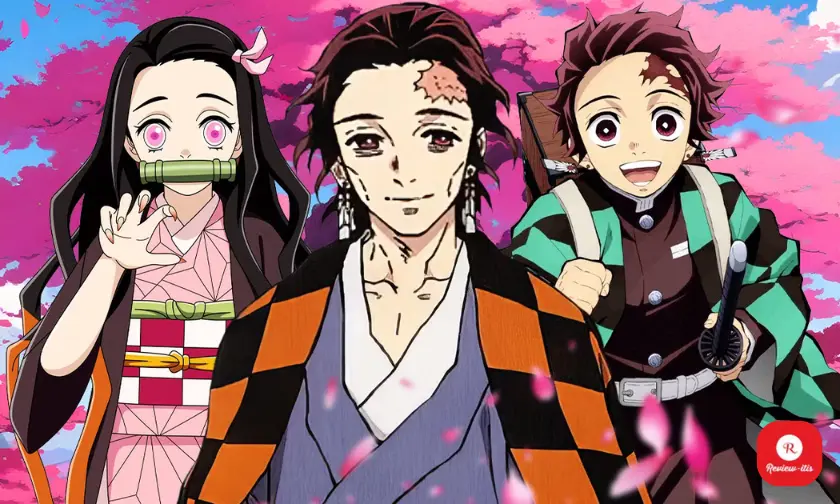
In this vibrant scene from episode 205 of Demon Slayer, the legacy of the Kamado family is beautifully carried forward into a peaceful modern era. Cherry blossoms float delicately in the air as Sumihiko Kamado, full of energy and joy, leads the charge down the stairs, waving enthusiastically with a big smile on his face. His carefree nature is a stark contrast to the hurdles faced by his ancestors.
Walking alongside him are his composed older brother, Kanata Kamado, who exudes a sense of responsibility, and two other modern-day descendants. A girl with a cheerful smile and bright eyes walks beside Kanata, holding his hand as they enjoy the surroundings.
This depiction is a heartwarming reminder of how far the Kamado family has come, from a past full of intense battles and loss to a beautiful present filled with hope, laughter, and ordinary moments like heading to school, bursting with life and harmony, reflects the ultimate triumph of peace after generations of struggle, symbolizing a bright and promising future.
The Agatsuma Legacy

Set in modern-day Tokyo, this scene humorously shifts the intense, action-packed world of Demon Slayer into a peaceful slice-of-life moment. Agatsuma Yoshiteru, a lively 17-year-old, sits outside his family’s home, engrossed in a book. With wide eyes and tears of wholesomeness streaming down his cheeks, he excitedly exclaims, “Wow! Amazing!! They won!! Everybody worked together to take down the demon boss!”
The book he’s indulged in, is none other than a fictionalized retelling authored by his great-grandfather, Zenitsu Agatsuma, whose tales of heroism are now cherished family stories.
Inside the house, a playful sibling banter unfolds. A younger family member, noticing Yoshiteru’s enthusiasm, while kicking Yoshiteru, makes a witty remark, “You’re reading great-grandfather’s science fiction again?” as Yoshiteru yelps from being kicked, exclaiming, “You kicked my back again?” Their banter adds a comedic touch, contrasting the dramatic legacy of their ancestors.
This light-hearted moment captures the enduring impact of the past on present generations, showcasing how the Kamado and Agatsuma families’ sacrifices are remembered in a world now free of demons.
The Agatsuma Family in Modern Times
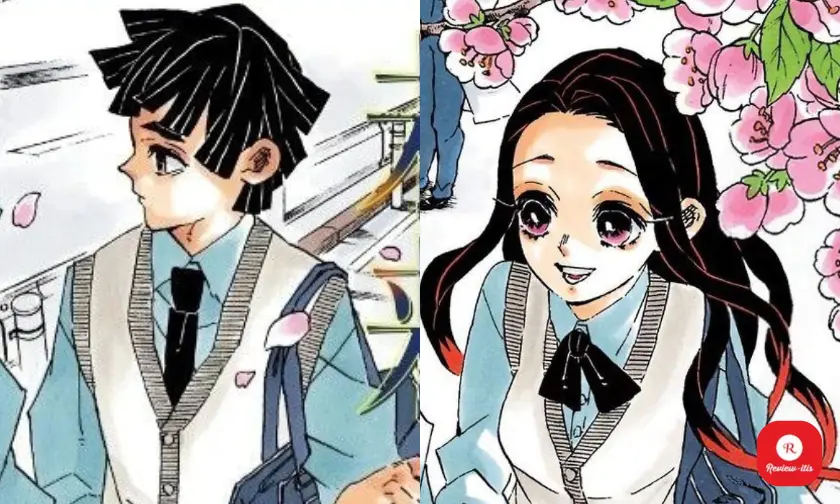
This lively scene brings us into the world of the spirited Agatsuma siblings, now living in peaceful modern-day Tokyo. Agatsuma Touko, a sharp-tongued and determined 18-year-old, scolds her younger brother Yoshiteru for his lack of focus.
“We don’t even have that much time left until our exams, you’re crazy!” Touko scolds, her piercing glare cutting through Yoshiteru’s enthusiasm. “Last time you failed! Then why don’t you study so that you don’t embarrass yourself too?”
But Yoshiteru, ever the dreamer and overly sentimental, is lost in the fictional tales of his great-grandfather Zenitsu’s demon-slaying adventures. With tears in his eyes, he passionately defends himself, shouting, “No, I’m telling you, everyone was amazing! They fought with their lives on the line!”
The argument spirals into classic sibling chaos. Touko grabs Yoshiteru by the ear, exclaiming, “GUAHH~ My ear!” Meanwhile, he cries, “Why did only my sister get mutated!?” teasingly referring to her fiery personality. Touko quips back sarcastically, “All the women in our house are so well-behaved!” while Yoshiteru, overwhelmed, cries out, “What!? Why bring this up? Are you angry now!?”
Amid the humorous exchanges, Yoshiteru’s curiosity takes a philosophical turn. “Hey nee-san, do you believe in reincarnation?” he asks, trying to divert the conversation. The moment is a delightful mix of sibling rivalry, humor, and sentiment, showing how the Agatsuma family thrives in a world free from the dark struggles of their ancestors encapsulating the lighthearted bonds of family and the enduring connection to their heroic past, blending everyday life with subtle nods to the legacy they carry forward.
A Legacy of Hope
In the next scene, the younger generation reflects on the sacrifices of their ancestors while embracing the vibrant world around them. Touko Agatsuma and her sibling Yoshiteru are engaged in an insightful conversation. Touko solemnly states, “The people who lost their lives fighting demons for the sake of peace… I believe. I’m sure they’re all reborn and living happy lives.”
This heartfelt sentiment transitions into a lively moment as they turn their attention to the news. Uzui Tenma, a 20-year-old gymnast and descendant of Tengen Uzui, has just won a gold medal for Japan in gymnastics. “Ah, so cool!” Touko exclaims with stars in her eyes, while Yoshiteru fumbles with the news, asking, “Huh? What’s this news?” Touko, clearly amused, teases, “I guess if you’re handsome, you can be forgiven for anything.”
But not everyone is impressed. Watching Tenma’s cocky demeanor, another remarks, “This guy is making a face and mocking the reporter. What a trash personality.” The juxtaposition between Tenma’s confidence and the admiration of his fans adds a comedic touch to the scene.
Through this lighthearted exchange, the legacy of courage and sacrifice from Demon Slayer’s past seamlessly integrates with the modern achievements and quirks of its descendants. It’s a reminder that even in a world free of demons, the spirit of resilience, humor, and hope continues to thrive.
Echoes of Hashibira
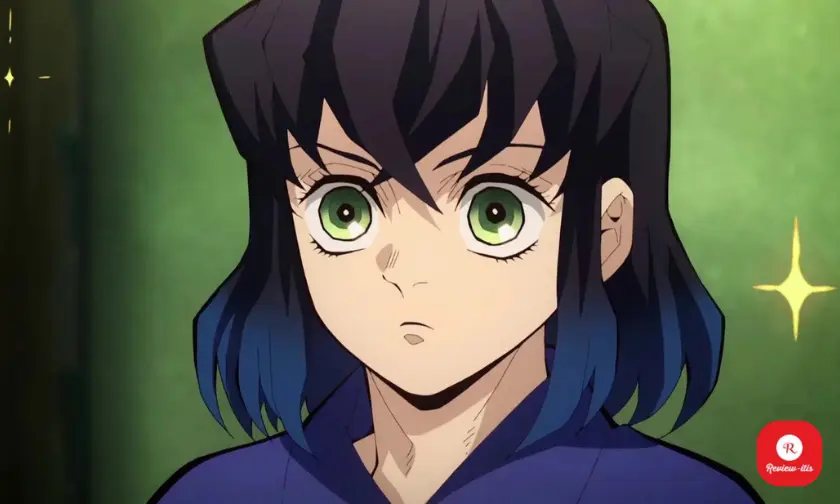
This delightful scene introduces Hashibira Aoba, a talented botanist and descendant of the wild and free-spirited Inosuke Hashibira. Aoba’s achievements in the modern era are highlighted in a television program as she’s recognized for her discovery of a new variant of the Blue Spider Lily. “It only comes out two or three days of the year and only blooms during the day,” the program narrates, showcasing her dedication and expertise. Though her brilliance shines, the commentary humorously remarks on her appearance: “A hit to self! Hashibira Aoba-san… she’s really pretty! Zoom in!”
Aoba’s rise to fame hasn’t been without challenges. The program acknowledges, “She’s been criticized a lot… she let them all wither by mistake.” This mix of professional triumphs and stumbles adds a human touch to her story, reflecting her journey as a scientist striving for perfection.
Meanwhile, a comedic subplot unfolds with Yoshiteru Agatsuma, who, upon hearing about Aoba, dramatically complains, “How could anyone attack such a poor, beautiful person like that?” His exaggerated reactions and tendency to idolize others echo his great-grandfather Zenitsu’s dramatic flair. In the background, someone humorously reminds him of reality, “That person is a man,” to which another playfully retorts, “Die, go and die!”
Amid these antics, the scene shifts to a quieter moment as a passerby points out, “Ah, look there!” A young woman pushes a stroller carrying adorable twins, prompting the comment, “Those twins are cute.” This calm conclusion serves as a reminder of the peace and happiness that this modern world now holds, a stark contrast to the endangered lives their ancestors once led.
The Agatsuma and Kamado Descendants
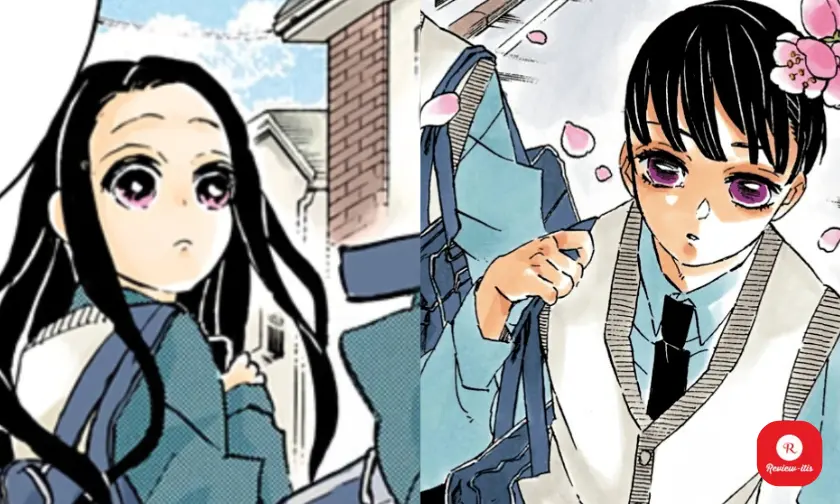
In this humorous and lively scene, Touko Agatsuma and her friends shows the playful chaos of modern-day life. Yoshiteru Agatsuma, as usual, finds himself in an awkward situation, gazing dreamily at a group of girls from the Sekirei Girls’ School. “They smell so good…” he mutters with hearts in his eyes, prompting an embarrassed response from Touko: “I’m not disgusting!”
The atmosphere shifts when Kanata Kamado enters the scene, catching Touko’s attention. “Ah, Kanata!” she exclaims, blushing and waving enthusiastically. Kanata, ever calm and collected, greets her with a polite, “Hello, Touko,” while Touko becomes agitated with admiration. “The way you did your hair today is cute,” Kanata remarks, making her heart flutter even more. The other girls giggle, declaring, “Touko is the cutest in the world! And Kanata is the most handsome one!”
Meanwhile, Yoshiteru tries to divert attention from his earlier foolish behavior with a quirky comment: “These days I’m studying how to curse people by looking at them.” However, his attempt at humor falls flat, and he quickly retreats, apologizing, “I’m sorry…” as everyone else looks on in mild confusion.
This lighthearted scene perfectly captures the youthful spirit of the Kamado and Agatsuma descendants.
Life in the Modern Kamado Era
This light-hearted moment begins with a busy preschool playground, where a towering preschool teacher in a too-small pink apron tries to manage the chaos. Yoshiteru observes the scene, sweating nervously as he whispers, “He’s huge! That preschool teacher… That pink apron seriously doesn’t fit!” The lighthearted commentary adds a playful contrast to the mundane morning setting.
Meanwhile, the conversation shifts to the ever-late Sumihiko Kamado. “What about Sumihiko-kun?” someone asks. The response, “I think he’s still asleep. He’ll be late today,” is met with resigned acceptance, a nod to Sumihiko’s never ending laziness, a running gag in their family dynamics.
Later, the group plans their next move, with someone suggesting, “Since we have morning classes today, do you want to go have lunch at that restaurant?” Excitedly, they agree. “You mean the one full of snake decorations that serves huge portions?” “Yeah!” they exclaim, their faces lighting up with anticipation.
The scene takes an amusing turn as someone recalls an unusual incident at the restaurant. “Actually, the other day…the husband threw a knife from out of the kitchen for staring at his wife with the braided hair’s chest” , recounting a dramatic moment where a husband, in a fit of jealousy, threw a knife at a customer. “It’s a bit uncomfortable there,” one remarks dryly, humorously undercutting their initial excitement.
This snapshot of the Kamado descendants’ everyday life blends humor and warmth, capturing the charm of their peaceful era. Whether it’s oversleeping, giant preschool teachers, or comical restaurant mishaps, these moments highlight the joy and simplicity of a demon-free world.
Morning Chaos
This snapshot humorously captures the modern-day antics of the Kamado and Agatsuma descendants. It begins with Yoshiteru Agatsuma in yet another awkward situation, trying to defend himself. Flustered and panicking, he exclaims, “No, no, it’s a false accusation!” as his companions, unimpressed, in disbelief, look at him. Touko’s piercing gaze makes it clear she isn’t buying his excuses.
Meanwhile, in typical fashion, Sumihiko Kamado oversleeps yet again. He bolts upright in bed, surrounded by his cheerful duck-print blanket, his expression filled with panic. “Why didn’t anyone wake me up~?” he cries, glancing at the clock. Realizing the time, he mutters to himself, “Wow, it’s late,” as the world outside continues its peaceful, routine rhythm.
The combination of Sumihiko’s never ending laziness and Yoshiteru’s comic defensiveness brings a lighthearted charm to the scene. These moments of chaos and humor perfectly reflect the casualness of their everyday lives, a stark and welcome contrast to the grave adventures of their ancestors.
This mix of sibling-like banter and relatable struggles highlights the peaceful world they now inhabit, where oversleeping and misunderstandings take center stage instead of life-threatening battles.
Sumihiko’s Rush to School
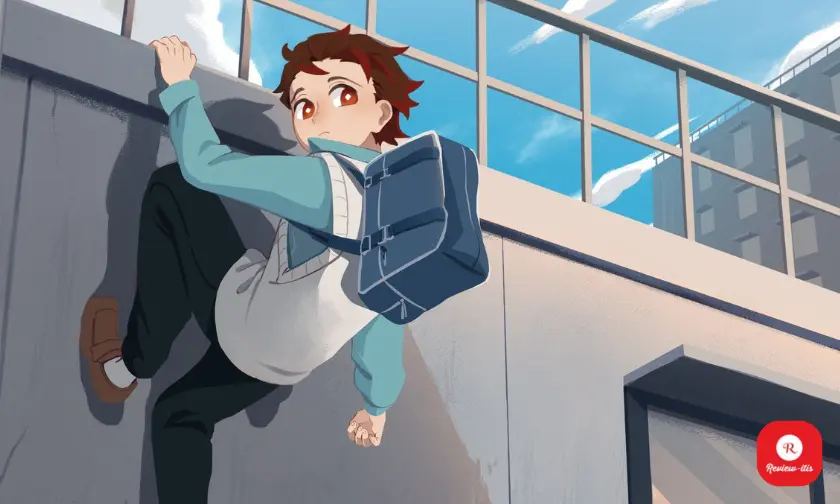
This dynamic scene features Sumihiko Kamado, the spirited modern-day descendant of the Kamado family, displaying his inherited agility and determination. As he jumps out of the window, he shouts confidently, “I’ll be back, Mom!”, he scales down the building like a seasoned parkour expert.
Sumihiko’s focus is clear as he races against time, determined not to let his lateness ruin his attendance record. His thoughts reveal his driving force: “I want that perfect attendance award.” Despite his composed external appearance, the urgency in his actions underscores his goal, transforming a simple commute into an acrobatic spectacle.
This comedic yet impressive display of athleticism highlights Sumihiko’s resemblance to his heroic ancestors, blending their exceptional physical abilities with the challenges of modern life.
A Thrilling Chase
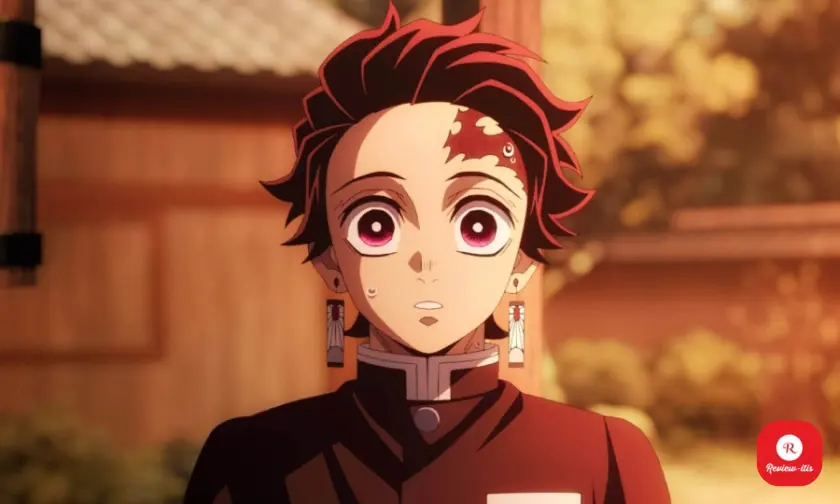
The scene captures a chase across the rooftops, where every leap and every breath feels like a race against time. It was Tanjiro Kamado, the determined protagonist, leading a group of students as they sprint across a rooftop.
Their movements are effortless yet intense, indicating the gravity of their mission. Tanjiro, ever the focused leader, grips the edge of a ledge and pulls himself up while urging himself forward. His breathless dialogue, “Gotta hurry… Hurry,” reflects the critical nature of their situation. Tanjiro’s face is a mix of exhaustion and resolve, showing his unyielding spirit even in the face of overwhelming pressure.
Behind Tanjiro, his companions mimic his urgency, their every motion precisely illustrated to highlight their shared desperation. The sound of their footsteps, “Hup,” “Pant,” and “Thud”, brings life to the action.
The group continues their running, across a series of angular rooftops, their shadows stretching across the textured skyline. There path was dangerous. One slip or moment of hesitation could spell disaster, but none of them hesitated.
As the chase unfolds, Tanjiro’s determination becomes the emotional anchor of the scene. His ability to keep on moving, despite tiredness, reflects his role as the group’s moral and physical leader. While the exact reason for their urgency is not detailed here, their actions make it clear that the stakes are immensely high.
A Humorous Side of Demon Slayer
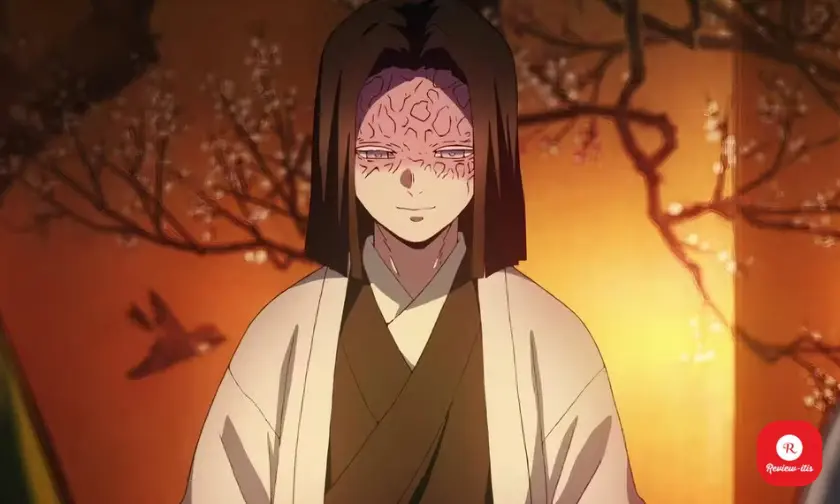
The sequence begins with Tanjiro scrambling across a rooftop with deep focus. Despite his clear determination, the young Demon Slayer still manages to maintain his courtesy. As he hurriedly leaps down from the roof, he shouts, “I’m sorry, coming through!” to the people he disrupts below.
While racing, Tanjiro enters a traditional wooden veranda where two individuals, seated peacefully, are caught off guard by his sudden appearance. One of the men exclaimed, “What are you doing this for every morning?” Their expressions, filled with both annoyance and tension, humorously contrast with Tanjiro’s hurried apology as he continues on his way.
The narrative shifts briefly to introduce the setting of Ubuyashiki Kagaya, the leader of the Demon Slayer Corps. He’s introduced as “the oldest person in Japan, the record-holding Ubuyashiki-san.” His calm presence and the peaceful atmosphere shows starkly contrast with Tanjiro’s chaotic sprint.
The humor of the moment is further increased by the commentary of another bystander who remarks, “Kids these days…” as Tanjiro’s behaviour continue to unfold. This light-hearted grumble adds a touch of relatability to the scene, as the elders shake their heads in amusement and mild frustration at the boundless energy of youth.
Despite the chaos, Tanjiro never falters in his journey, embodying his determination to fulfill whatever mission is driving him forward. His politeness, even in the midst of disruption, showcases his good-hearted nature.
The Running Man
This humorous scene from Demon Slayer showcases Tanjiro Kamado’s relentless drive, paired with his characteristic politeness, as he runs through the streets, creating chaos along the way. The scene begins with Tanjiro running past a group of schoolchildren. “Ah, sorry!” he exclaims, with his voice, filled with urgency and embarrassment. The children, wide-eyed and confused, react with cries of “Kyaa!” and one of them nicknames him “The Running Man.” Tanjiro mutters to himself, “Uwah, I got a strange nickname!” This mix of determination and awkwardness perfectly captures his endearing personality.
As he moves ahead, reaches a traffic jam where, a confused driver, squinting at the traffic lights, mutters, “I can’t see it,” while a passenger advises, “Well, slow down.” The mundane yet comedic commentary contrasts with the chaos Tanjiro leaves in his way, adding a touch of everyday humor to the chase.
The tension ramps up when Tanjiro spots a police car in his path. Instead of stopping, he exclaims, “Ah, I can’t stop for the police car…” His conflict between respecting the law and maintaining his mission is both amusing and reflective of his dutiful nature.
Tanjiro’s High-Flying Escapade
In another chaotic moment, Tanjiro Kamado’s unshakable determination takes an unexpected turn. The scene begins with Tanjiro mid-sprint, when he suddenly leaps into a dramatic flip over the vehicle. His polite nature remains intact as he yells, “Ah~ I’m sorry!” even while executing the acrobatic skills.
The perspective shifts to the confused police officers inside the car. One officer sits in stunned silence, his disbelief, as he processes the sudden intrusion. Another officer, equally confused but quicker to react, mutters, “I thought you hit a person for a second, that son of a b***h…”
As the realization sets in, the officers recognize the culprit. “That’s definitely the high school kid that’s been reported seven times,” one remarks, with the other affirming, “Yeah.” Their expressions convey a mix of frustration and resignation, suggesting this isn’t their first encounter with Tanjiro.
Tanjiro’s Kindness
This scene from Demon Slayer highlights Tanjiro Kamado’s mix of urgency, determination, and kindness. As the sequence begins, Tanjiro is seen sprinting up the street, visibly stressed and panting. “Can I make it on time?” he wonders, his face filled with worry. “Aah, this is bad,” he adds, showing how much serious this task is to him.
During his anxious pace, he notices a group of children chatting and comparing collectibles. One exclaims, “Let me see, let me see! What did you get?” as they admire Zaichi-kun’s rare collectible item. Another child says, “I’m jealous, you’ve got duplicates,” while Zaichi proudly holds up his treasure. Tanjiro, even in his rush, pauses briefly to admire the scene. With an encouraging smile, he adds, “Wow, awesome Zaichi-kun, that character is rare!”
The children, moved by Tanjiro’s kindness, offer him one of their duplicates. “You can have it,” they say, sensing his genuine appreciation. “Ooh! Really? I don’t have any more allowance,” Tanjiro responds with gratitude. Despite his own tough schedule, he takes a moment to show his good-natured side, leaving the kids even more delighted.
As the scene transitions, Tanjiro dashes off again, racing toward his destination. This small moment is a reminder of his core character—kind, selfless, and always focused on connecting with others, no matter how pressed for time he may be.
A Glimpse Into School Life and Art Appreciation
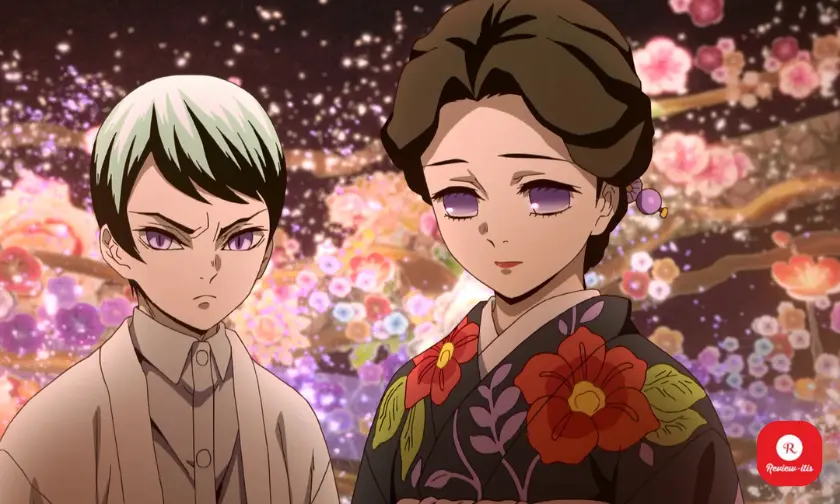
In this delightful scene, there’s a group of schoolboys. It appears to be a casual school day, with students engrossed in their conversations and smartphones.
At the center of this interaction is Gotou, a student who is intently looking at his phone, lost in thought. The story humorously begins with a relatable warning displayed: “Don’t use your phone while walking down the street.” Gotou’s focus on his phone captures this universal cautionary note.
Takeuchi, one of Gotou’s friends, approaches him from behind, saying, “Ah, you scared me,” initiating their conversation. The dialogue takes a lighthearted turn when Takeuchi teasingly looks at Gotou’s phone and remarks, “Gotou, that isn’t your girlfriend, is it?” The playful accusation leaves Gotou momentarily nervous.
Gotou quickly clarifies the situation, replying, “No, this person…” He gestures towards the image on his phone, which depicts an artistic portrayal of a woman. Another friend, Kazumi-kun, joins in and confidently declares, “It’s a painting, I know all about it.” His self-confident expression suggests he’s eager to impress or perhaps show off his knowledge. This scene subtly conveys the warmth and bonding shared among friends, spiced up with gentle teasing and curiosity.
The Mysterious Art of Yamamoto Yushirou
In this engaging scene, a group of students, with wonder, looking at the artwork of a mysterious painter, Yamamoto Yushirou, whose paintings have recently gained global recognisation. This artist has captivated the world with his beautiful portraits, all centered around a single subject: a beautiful woman named Tamayo.
One student narrates, “Recently it’s been highly praised worldwide and begun to draw attention…” The scene highlights the divine beauty of Yushirou’s works, displaying canvases featuring Tamayo in various poses, with different surroundings like that filled with roses and fans. The level of detail leaves the students mesmerized. One exclaims, “Huh!? This is a painting!? It’s almost like a picture,” encapsulating the realism that Yushirou’s art achieves.
The intrigue deepens as another student provides insight into the artist’s skill. “It’s the work of the mysterious man Yamamoto Yushirou, a painter who continues to depict only a beautiful woman named Tamayo.” This obsessive dedication adds an air of mystery and romanticism to the painter’s legacy.
However, the conversation takes a surprising turn when another student reveals, “He’s an artist that shot a rifle at a reporter that came to get an interview.” This shocking revelation bring to life, a shocking scandal to the artist’s fame. The reaction from the group is a mix of disbelief and criticism. “Is the artist that violent?” one asks, to which another replies bluntly, “That’s messed up.”
As the group moves on, reflecting on Yushirou’s fame, one student remarks, “My first love was number 812, ‘Glass Flowers and Tamayo,” suggesting the artist’s work has inspired deep emotions and personal connections among his admirers.
The final reflection, “Who was he? That guy…” underscores the mystery surrounding Yamamoto Yushirou. This scene effectively captures the allure of art, the complexities of its creators, and the way both beauty and controversy can immortalize an artist’s legacy.
Camaraderie of Sumihiko and Tanjiro
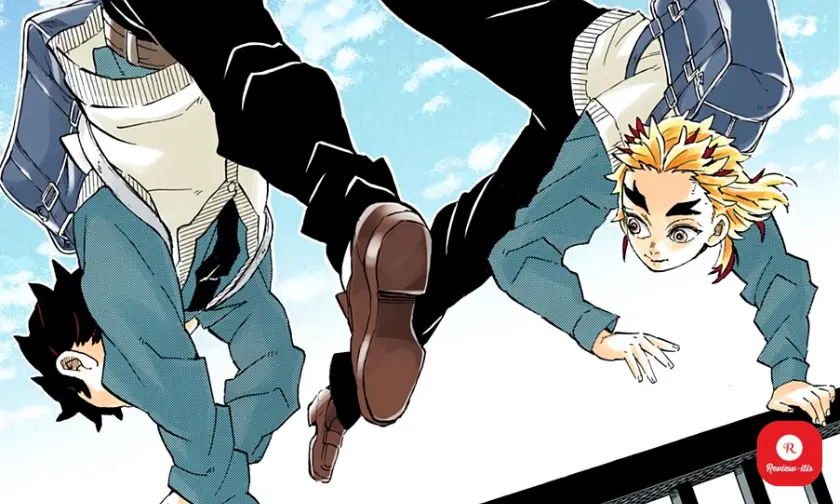
This scene captures the spirited morning routine of two energetic students, Sumihiko and Tanjiro, as they dash through the streets. The scene is lively and filled with youthful enthusiasm, giving readers a sense of their strong friendship and their driven personalities. The action begins with Sumihiko, seen sprinting through the city streets with determination. He was clearly in a rush.
As Sumihiko catches up to his friend, Tanjiro, the scene brightens with cheerful greetings. Tanjiro enthusiastically calls out, “Good morning!” with a bright smile, while Sumihiko responds with equal enthusiasm, “Hey Tanjiro-kun!” Their radiant expressions showcase their excitement and friendship.
The conversation quickly shifts to why Sumihiko is late. Tanjiro asks, “Why are you late?” to which Sumihiko provides an unexpected and humorous answer: “It’s because I’ve been focused too much on sparring since 4 a.m.!” This revelation not only highlights Sumihiko’s dedication to self-improvement but also adds a layer of comedic charm, as waking up so early to train would leave anyone rushing to school.
The final scene shows both boys running side by side, backpacks bouncing as they race through the streets. Their determination and youthful energy shine, underscoring their shared commitment to bettering themselves while supporting one another.
A Spirited Conversation
The scene begins with a tense moment as a police car pulls up, commanding, “You high school students there, stop for a bit!” The sharp contrast between the police’s grave tone and the boys’ cheerful energy sets the stage for a humorous interaction. Despite the slight alarm, the boys keep their focus on their conversation, dismissing the moment with laughter.
Tanjiro takes the lead, enthusiastically encouraging Sumihiko to join the kendo team, saying, “Why don’t you join the kendo team, Sumihiko?” His confident tone show his belief in Sumihiko’s potential. Tanjiro’s commitment to getting his friend involved in sports doesn’t waver as he adds, “I think you’re a perfect fit for sports!”
Sumihiko, on the other hand, responds with a mix of practicality and humor. “I’m not entering those. It’ll cut down on the time I can sleep,” he says, prioritizing his rest over extracurricular activities. His down-to-earth and humorous response brings balance to the conversation.
The scene takes another lighthearted turn when Tanjiro reflects, “Until my dad slapped me, no one had said anything.” This reveals his own experience of being pushed into taking action, which increases his insistence on Sumihiko getting involved. Tanjiro adds, “I don’t even care if you pick something else, but you have to play a sport,” showcasing his passionate belief in the importance of staying active.
The police car chasing them, commands “Stop right there, short-haired student!” This adds a comedic layer of urgency, as the boys continue their discussion without missing a beat.
Tanjiro’s further encourages his friend and continues with, “Come on! Just for a bit!” as he maintains his enthusiasm. Meanwhile, Sumihiko playfully dodges the suggestion, underscoring their lighthearted friendship.
A Chaotic School Morning
This scene from Demon Slayer presents a humorous and thrilling moment as Tanjiro and Sumihiko sprint towards school, showcasing the high-energy chaos of student life. As the scene starts, a police car in pursuit, the officer shouts, “I said stop, you brats!” However, Tanjiro and Sumihiko, unbothered, continued their race, showcasing their carefree and spirited personalities.
Tanjiro, ever enthusiastic, exclaims to Sumihiko, “You’ll like it so much that if you start, you won’t be able to hear anything else!” Sumihiko, in a burst of laughter, replies, “Ahaha, I’m sure I’d lose to Tanjiro-kun,” accepting his friend’s endless energy and competitive streak.
Meanwhile, at the school gates, where panicked staff rush to shut them in time. A teacher yells, “Quickly! Quickly! Close it!” and dramatically adds, “There’s a dangerous repeat offender going to this school!” The exaggerated statement humorously paints Tanjiro and Sumihiko as mischievous troublemakers.
Despite the commotion, the two boys remain cheerful and confident. As the gates close behind them, Tanjiro shouts, “Yeah!” while Sumihiko reassures, “Looks like we won’t be late.” Their unwavering optimism and playful energy contrast sharply with the school staff’s chaotic response, making the scene both comedic and relatable.
This scene depicts the boundless energy and daring spirit of Tanjiro and Sumihiko as they, in mid-air, vaults over a school gate with amazing coordination and confidence.
The scene than shifts to a view of the school staff and other students on the ground, stunned by the duo’s thrilling move. Their carefree expressions during the jump highlight their knack for turning even routine moments into highly energetic adventures.
An Amazing Victory
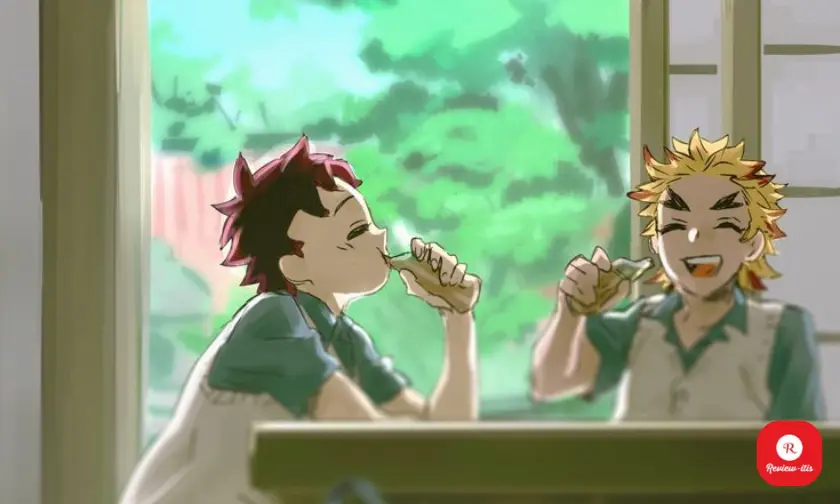
This scene from showcases the aftermath of Tanjiro and Sumihiko’s daring attempt to make it to school on time. Their expressions radiates the relief as the pair celebrates their bold and chaotic morning.
Tanjiro, filled with excitement, throws a fist in the air and shouts, “We did it!” Meanwhile, Sumihiko, still catching his breath, adds, “That was close, but we’re safe.” Their shared sense of accomplishment is evident from the happiness on their faces.
The focus then shifts to the law enforcement officers and staff who had been involved in the morning’s chase. A chilling moment unfolds as one officer, with a smile, approaches and says, “Can we talk for a minute?”
The scene humorously cuts to a new perspective. Behind the school gates, a worried individual mutters, “I think I’m gonna get fired from the lab,” likely reflecting the fallout of the boys’ wild stunts. Despite the tension and chaos, a voice calmly observes, “The world is peaceful again today.” This ironic statement underscores the blend of mischief in their lives, wrapping up the scene with humor.
A Heartfelt End
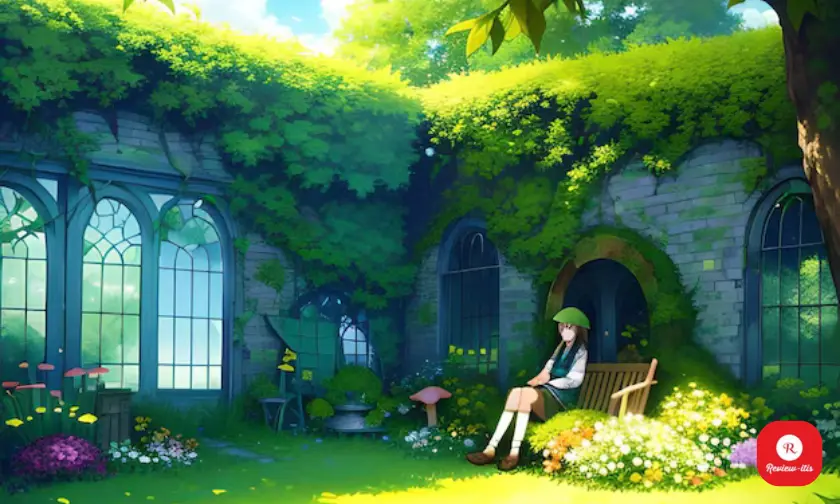
The scene begins with a serene shot of a woman sitting on a park bench, expressing her longing for peace. She says, “I want to live alone in the mountains,” a quiet desire that contrasts with the energetic events of the series. This moment is interrupted by a phone call, where the caller introduces themselves: “Yes, this is Kamado.”
The mood shifts as the recipient of the call reacts in shock, shouting, “What!? My son!?” Her disbelief and concern are mysterious as she clutches the phone, standing in a room filled with photographs and a sword mounted on the wall which is a visual reminder of the legacy and adventures of the Kamado family.
Moving ahead, the caller apologizes politely, saying, “I’m so sorry for the inconvenience…” This brief interaction bridges the peaceful domestic scene with the chaotic and action-filled history of the characters.
Conclusion
The journey of Tanjiro Kamado, the story beautifully explores themes of family, sacrifice, and perseverance, while presenting a world filled with well-developed characters and compelling villains.
The final frame is a heartwarming group shot of the cast, radiating joy and mutual trust. Each character, from central figures to side companions, is shown smiling and celebrating, capturing the spirit of unity and the bonds forged throughout the series. This joyful gathering leaves a lasting impression, emphasizing the themes of friendship, resilience, and family.
The series not only entertains but also leaves a lasting impact on its readers, inspiring them with its messages of hope, determination, and the strength to overcome adversity.
To read more similar articles, click here.
Thanks for visiting our Website. If you appreciate our work, kindly show us some support in our comments section 🙂